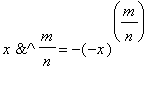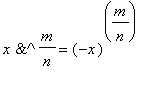 is a fraction we have the following cases:
is a fraction we have the following cases:


 is complex.
is complex.
Function: &^ - "elementary" fractional powers
Calling sequence:
x &^ p;
Parameters:
x, p - any algebraic expressions. Numerical values of p should be rational numbers.
Description:
 is a fraction we have the following cases:
is a fraction we have the following cases:


 is complex.
is complex.
Examples:
> evalc((-1)^(1/3)), surd(-1,3), (-1)&^(1/3);
![]()
> evalc((-1)^(1/4)), evalc(surd(-1,4)), evalc((-1)&^(1/4));
![]()
> evalc((-1)^(2/3)), (-1) &^(2/3);
![]()
> evalc((-1)^(5/8)),evalc((-1)&^(5/8));
![]()
> assume(n<0): n &^(3/5), n &^ (4/5);

> plot(x &^ (2/3), x = -1 .. 1);
> plot(x &^ (3/5), x = -1 .. 1);
See also: ^ , Fractional powers of negative numbers , surd
Maple Advisor Database R. Israel 1998